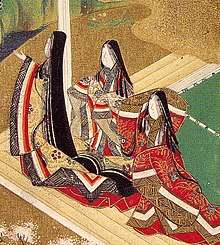Zōri
Zōri (草履) are flat and thonged Japanese sandals made of rice straw, cloth, lacquered wood, leather, rubber, or—most commonly and informally—synthetic materials.[1]
| Look up zōri in Wiktionary, the free dictionary. |
.jpg) Men's zōri | |
| Type | Japanese sandal |
|---|---|
| Material | rice straw, cloth, lacquered wood, leather, rubber or synthetic materials |
| Place of origin | Japan |
Similar in form, modern flip-flops became popular in the United States, Australia and New Zealand when soldiers returning from World War II brought Japanese zōri with them.
Use
Like all Japanese sandals, zōri are easily slipped on and off[1], which is important in Japan, where shoes are removed and put back on when entering and leaving a house, and where tying shoelaces would be impractical in traditional wear.
The traditional forms of zōri are seen when worn with other traditional clothing[1]. Modern forms are fairly common, however, with casual Western wear, especially in summer. While geta are now mostly worn with the informal yukata, traditional zōri are often worn with the more formal kimono.
Formality
The formality of the occasion affects the choice of zōri.
Bulrush covered zōri that resemble tatami mats are not worn with kimono, but are considered working wear or are sometimes matched with casual Western or Japanese clothing.
Vinyl or plastic zōri are next in formality. They are worn with formal clothing such as a semi-formal kimono; e.g. for a festival. The most formal of zōri are only for women; they are brocade covered zōri that are used with the most formal of kimono, for example, wedding and funeral wear.
The hanao, or thongs, are either white or black, depending on the occasion[1]. They are placed in the center, so there is no difference between the left and right shoe. One wears white hanao zōri as formal wear, as opposed to wearing a black hanao zōri for informal wear. One should almost always wear tabi.
Materials
Hanao
The hanao of informal zōri can be made of a velour-like material, as in the case of straw imitation zōri. The hanao for more formal colored vinyl zōri are either vinyl or fabric straps. The fabric is often either the fabric used for the shoe, or chirimen, crepe-like Japanese silk or rayon fabric.
Men's zōri might also feature leather or leather imitation hanao.
The hanao wear and stretch easily, and they sometimes call for replacing. Sometimes, hanao can be replaced through flaps of the sole. At other times, the hanao cannot be replaced, and a new shoe must be purchased.
Different styles
Women's zōri are seldom flat, except for the straw imitation zōri. The soles come in different thicknesses and angles. There are even modern zōri that are left uncovered by fabric or vinyl, and the shoe, except for the inner sole, is black, hard plastic with a non-slip outer sole. Usually the outer sole is gray, genuine leather.
Gallery
 Side view of zōri
Side view of zōri Modern plastic women's zōri
Modern plastic women's zōri Straw zōri
Straw zōri Zōri being worn.
Zōri being worn.
References
- MATCHA. "Geta and Zōri - Japanese Encyclopedia". MATCHA - JAPAN TRAVEL WEB MAGAZINE. Retrieved 2020-03-12.
